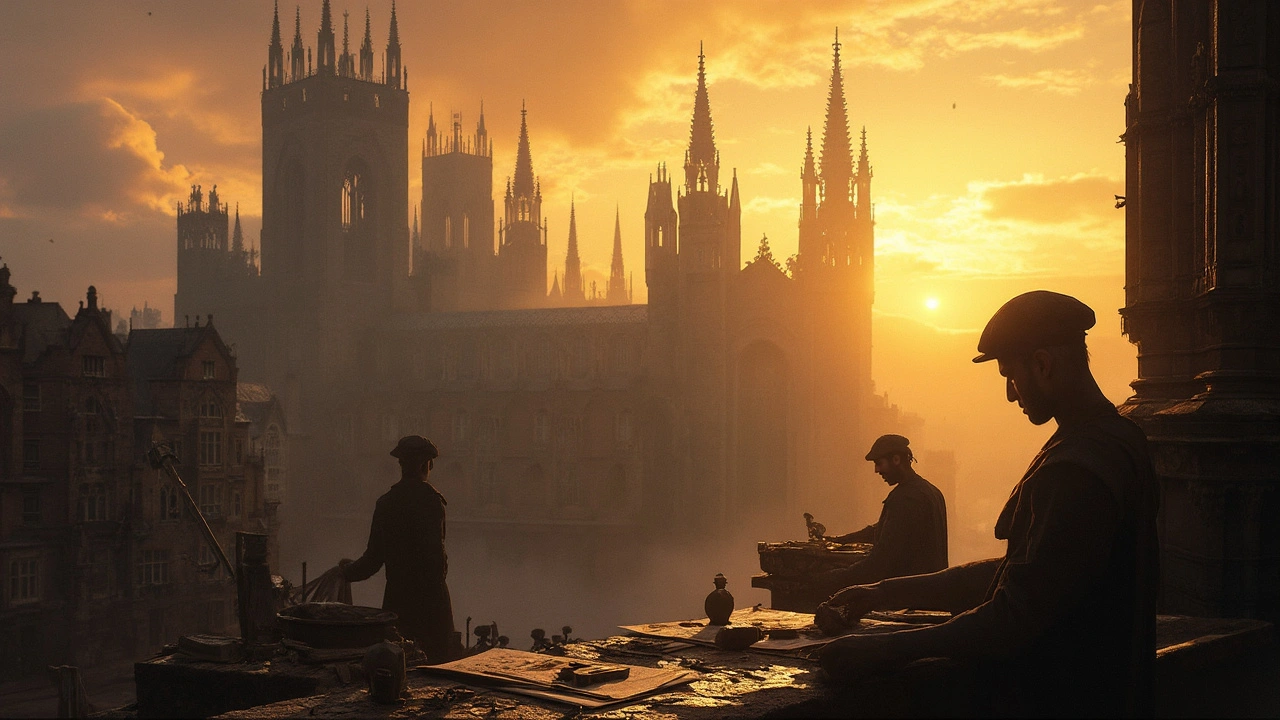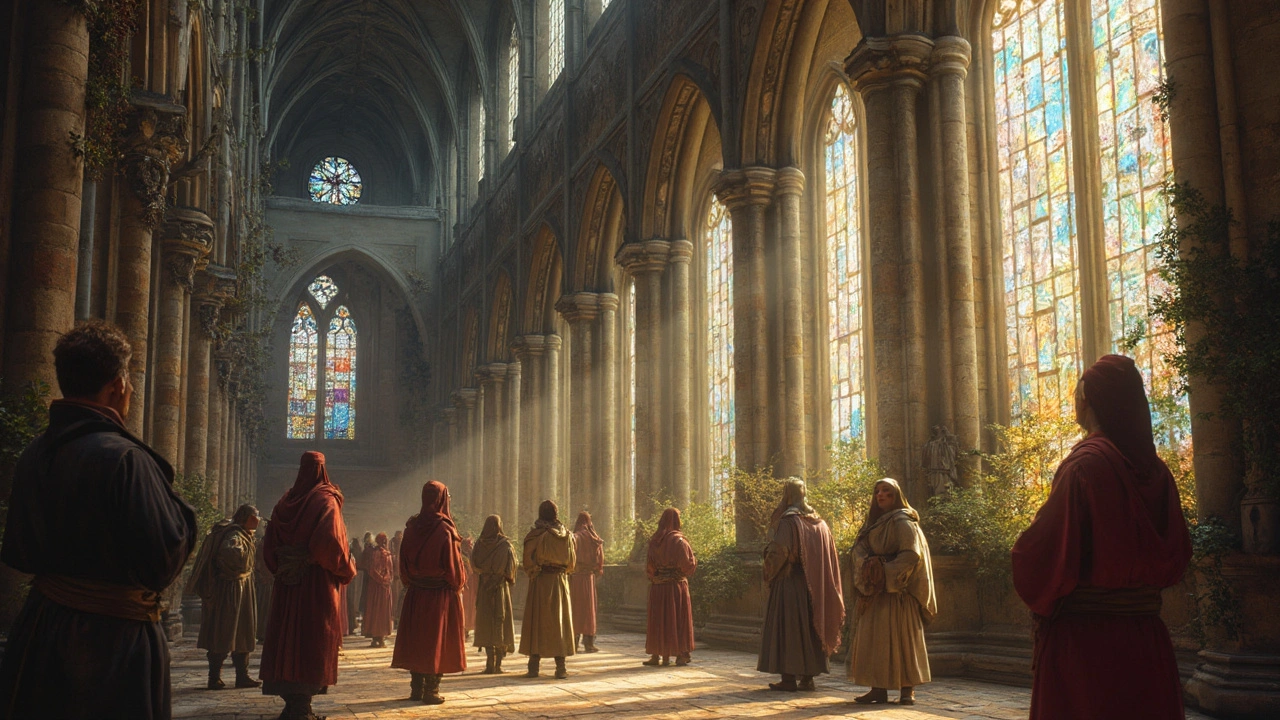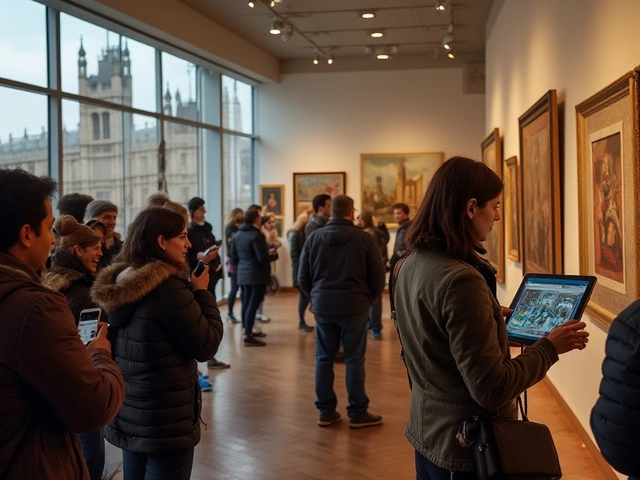Forget about gloomy castles and brooding gargoyles for a second—Gothic art did way more than just give us mood. It cracked open doors that medieval Europe barely knew existed, letting in fresh ideas and serious skill upgrades that would fuel the Renaissance.
Before Gothic art showed up, most European buildings and paintings looked a bit stiff, kind of like everyone was copying the same playbook. Things changed fast once people started thinking bigger, literally. Cathedrals shot up toward the sky, walls turned into canvases for sunlight, and artists began caring about how people actually looked and felt.
This shift didn’t just make buildings prettier. It set off a new focus on human stories, nature, and the power of imagination—stuff that later Renaissance legends would run with. If you look closely, you’ll spot plenty of these early experiments hiding in plain sight all over Europe.
- What Sparked the Gothic Shift?
- Gothic Cathedrals: The Ultimate Game Changers
- Art Gets Real: The Human Touch
- Bringing Light to Dark Times
- Building Bridges to the Renaissance
- How to Spot Gothic Roots in Renaissance Masterpieces
What Sparked the Gothic Shift?
Here’s the deal: gothic art didn’t just pop up out of nowhere. It grew out of big changes in society, religion, and tech. By the mid-12th century, Europe was restless. More people lived in cities, trade was booming, and towns wanted to show off what made them special. The Church wanted bigger, more impressive spaces, so folks could feel closer to the divine and their local community at the same time.
Before then, Romanesque buildings ruled the scene—thick walls, tiny windows, and not much light. But as construction tech got better, builders figured out how to use pointed arches, ribbed vaults, and flying buttresses. These tricks weren’t just for show. They made buildings way taller, with slimmer columns and massive stained glass windows. More light poured in, and for the first time, Sunday mass felt like stepping into another world.
- Pointed arches spread weight differently, so structures could be sky-high.
- Ribbed vaults let ceilings stretch wider without collapsing.
- Flying buttresses pulled weight away from the walls—so walls could become glass instead of stone.
Another thing: schools and universities (like the one at Chartres Cathedral) popped up around these new buildings. Artists, architects, and thinkers swapped ideas, pushing gothic art to get even bolder. These places became magnets for creative people, and their rivalry fueled some of the wildest buildings in Europe.
Population kept rising and so did the need for statements—cities fought for bragging rights with taller and fancier cathedrals. Fast fact: the spire at Notre-Dame de Strasbourg hit 142 meters, making it Europe’s tallest building for ages.
| Gothic Breakthrough | First Major Example |
|---|---|
| Pointed Arch | Saint-Denis Basilica, France (1144) |
| Flying Buttress | Notre-Dame de Paris (1163-1345) |
| Huge Stained Glass | Chartres Cathedral, France (1200s) |
This wild mix of competition, new tech, and shifting culture is what sparked the gothic art revolution. It set off a creative chain reaction that would eventually hit the Renaissance with full force.
Gothic Cathedrals: The Ultimate Game Changers
When you hear Gothic art, those wild, towering cathedrals are probably what jump to mind first—and for good reason. These places weren’t just for worship. They changed how people saw buildings and what architecture could pull off. Think of Notre-Dame in Paris or Chartres Cathedral in France. These giants were Europe's statement pieces from the 12th to the 16th centuries, shaping how cities looked and how people thought about faith, light, and even science.
Gothic cathedrals blew minds because they broke the rules. The key game-changer? The flying buttress. This support system made it possible to build way higher and add massive windows filled with stained glass. Instead of solid, heavy walls, you got open, bright spaces. This was a huge step up from the older, chunkier Romanesque style. How big was the difference? Some cathedrals doubled the height of what came before.
| Cathedral | Height (meters) | Construction Start |
|---|---|---|
| Amiens Cathedral | 42 | 1220 |
| Chartres Cathedral | 37 | 1194 |
| Notre-Dame de Paris | 33 | 1163 |
Inside, these cathedrals were like galleries for medieval art—statues, carvings, colorful windows telling Bible stories for people who couldn’t read. Suddenly, everyone could "read" the building with their eyes. Gilles Deleuze, a French philosopher, even said,
"The Gothic cathedral did not only let the light in; it made the invisible, visible."
This whole setup didn't just wow locals. It also inspired Italian artists to focus on realistic bodies, dramatic scenes, and emotion. The Renaissance picked up right where the Gothic left off—using those same ideas and pushing them even further.
If you're looking for inspiration, walk through a Gothic cathedral or check out a virtual tour online. Pay attention to how every column, statue, and window works together. It’s all about bringing big ideas to life, using the tools at hand. No wonder these buildings sparked a revolution in architecture and art history.
Art Gets Real: The Human Touch
Something wild happened in the world of gothic art around the 12th and 13th centuries—suddenly, statues and stained glass figures actually started to look like real people. Instead of flat faces staring straight ahead, you’d see saints with honest-to-goodness emotions, families hugging, angels reaching out with fingers that looked like, well, fingers. This was totally new for the time. Medieval art before gothic usually made people look stiff as if the artist was afraid to mess up the holy vibe.
Take the Chartres Cathedral in France as a real-life example. The sculptors there ditched the blocky style and tried to show movement and expression. If you walk around the cathedral today, you’ll spot kings and prophets that almost look like they’re about to step out and talk to you. The faces have personalities, the poses aren’t all the same, and the drapery actually falls like real cloth. This might sound minor, but in the world of art history, it’s a huge step forward.
Part of the push came from religious ideas changing—churches wanted folks to relate to the saints, not just admire them from a distance. So, artists used new tricks: carving deeper shadows, giving sculptures angled bodies, and making eyes that didn’t just stare blankly. This made stories feel more real and helped people connect emotionally during church visits. Stained glass also turned a corner, with scenes filled with action and more recognizable faces, thanks to brighter colors and smarter layouts.
- Sculptors started showing genuine emotions—pain, joy, awe—which set the stage for even more dramatic storytelling later on.
- Better tools and materials, like fine chisels and improved stone, let artists get all the tiny details right.
- Artists focused on nature—leaves, animals, and backgrounds stopped looking like cartoons and started matching what was outside church windows.
Here’s a quick breakdown showing how figures changed from the old Romanesque style into the new gothic look:
| Feature | Romanesque | Gothic |
|---|---|---|
| Facial Expression | Blank/Serious | Emotional/Varied |
| Body Position | Stiff/Straight | Relaxed/Natural |
| Clothing | Flat Carving | Flowing/Layered |
| Interaction | Little or None | Gestures/Holding Hands |
The big deal here is that gothic art made people seem alive in a way that hadn’t been done before. Later, during the renaissance, artists like Donatello and Michelangelo would take these early leaps even further, but it all started with gothic artists who decided that art could show real emotions. If you’re tracing the journey of medieval to modern, this is where things really start to get interesting.

Bringing Light to Dark Times
When people think about the Middle Ages, it’s easy to just picture gloomy stone halls and dim candlelight. But gothic art literally flipped the switch—making churches and cathedrals bright, colorful, and inviting. Big reason? Those massive stained-glass windows. Before gothic art showed up, churches had thick walls and tiny windows, just slits barely letting any light in. Once gothic architects started using flying buttresses, walls carried less weight. Suddenly, builders could swap heavy stones for huge panes of colored glass.
The math here is pretty wild. Some cathedrals, like Chartres in France, had almost half their wall space taken up by windows. All that colored glass didn’t just make things prettier—it told stories (like Bible scenes), taught lessons, and made even regular folks feel closer to heaven.
- Chartres Cathedral: its windows cover over 2,600 square meters—that’s almost half a football field’s worth of glass art.
- Sainte-Chapelle in Paris: known for its walls made almost entirely of glass, stacking over 1,100 individual biblical scenes.
This focus on light changed everything. Artists and builders started thinking of light as not just useful, but as a symbol. Suddenly, paintings got brighter, colors got stronger, and everyone obsessed over how to make spaces feel open instead of cramped. Historians even believe this interest in light inspired later renaissance painters to experiment with realistic shadows and sunsets in their art.
So next time you walk into a church and see light splashing through stained glass, remember—it’s gothic art shining through, literally and figuratively.
Building Bridges to the Renaissance
If you trace the roots of the renaissance, you'll spot a clear path leading straight through gothic art. It's not just a coincidence. The best ideas from the Middle Ages started piling up here, ready for the big handoff to artists and architects who’d soon flip the entire art world.
For starters, gothic architects weren’t shy about pushing boundaries. Look at Notre-Dame in Paris or Milan Cathedral. Their pointed arches and flying buttresses weren’t just for show—they let walls rise higher and windows get way bigger. That extra space meant more light and, honestly, more room to experiment. The same architects who played with these designs influenced Renaissance builders who wanted open, airy spaces instead of cramped, dark halls.
Stained glass artists also cranked up the wow factor. Those massive, colorful windows told Bible stories, but they did something else just as important: they set a whole new bar for color and detail. The focus on lifelike stuff, like plants and faces, turned “just decoration” into real storytelling. Renaissance painters took this and ran, working out new tricks with light, shade, and realistic backgrounds.
Skill was on everyone’s mind. Medieval master builders carried notebooks full of measurements, sketches, and even geometry lessons—think of these as early instruction manuals. When the Renaissance rolled around, these guides made it easier for artists like Leonardo da Vinci and Brunelleschi to dive into perspective, perfect buildings, and invent new art techniques.
Here’s a handy breakdown of how gothic art set the stage for renaissance breakthroughs:
- Architecture: Pointed arches, ribbed vaults, and buttresses inspired open, flexible design ideas.
- Light: Huge stained glass windows changed how artists thought about color and brightness.
- Human Focus: Sculptures and windows showed real emotions, giving artists a blueprint for natural expression.
- Technical know-how: Builders and artists wrote down what worked, so future generations could pick up where they left off.
There’s also a cool stat: By the 15th century, over a hundred gothic cathedrals dotted Europe, basically turning city centers into giant, hands-on art labs. You could argue that every single one gave Renaissance artists something to learn from as they pushed forward.
How to Spot Gothic Roots in Renaissance Masterpieces
Once you know what to look for, you’ll start seeing gothic art fingerprints all over Renaissance paintings and buildings. The so-called clean break between the two styles is kind of a myth; artists actually borrowed tons of tricks and ideas from their Gothic past.
Start with architecture. Walk into an early Renaissance church or city hall, and take a look up. If you spot pointed arches or those spiderweb-like ribbed vault ceilings, that’s pure Gothic DNA. A bunch of famous Italian buildings—like Florence’s Santa Maria Novella—mix these features with more square, Roman shapes. The same goes for stained glass windows that stay colorful and oversized, even when everyone’s claiming they’re done with medieval stuff.
Now check out the art on the walls. A lot of Renaissance painters, especially in the early days, still leaned on gothic art vibes for their details. For example, look at Giotto’s work. His figures finally have weight and flesh, but their halos, gold backgrounds, and tall, narrow frames echo straight out of Gothic altarpieces.
- Elongated figures or scenes that still look vertical and stretched—Classic Gothic move.
- Spiky or flowery patterns in clothing, frames, or borders—Gothic love for decoration didn’t die out overnight.
- Religious stories packed into one painting—Gothic art set the blueprint for these big storytelling canvases.
- Towers and doorways in background landscapes with that signature pointed arch shape—easy to spot once you’re tuned in.
To really see the weird overlap, line up a Gothic sculpture next to a Renaissance one. The older figure might look rigid and motionless; the new one has muscle and a twist in the body. But you’ll still catch similar faces, long flowing robes, and dramatic gestures in both. That’s not just coincidence—it’s evidence of gothic art teaching Renaissance artists how to be bold.
Here’s a quick snapshot of features you’ll often see sliding from Gothic into Renaissance artworks:
| Feature | Common in Gothic Art | Survives in Renaissance |
|---|---|---|
| Pointed Arches | Yes | Sometimes |
| Stained Glass Windows | Yes | Yes, esp. early on |
| Vertical Layouts | Yes | Often in religious art |
| Detailed Ornamentation | Big time | Continues for a while |
So next time you visit a museum or look up church photos online, don’t just pick a side. See how the boundary between gothic art and renaissance blurs. It’s a cool reminder that breakthrough art doesn’t start from scratch—it stands on the shoulders of what came before.




